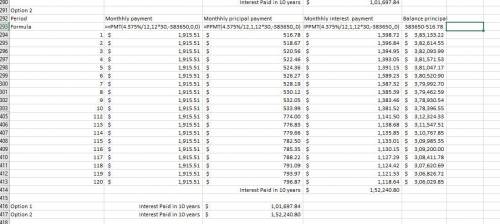
Dr. Bhattacharya and Dr. Malinowski are considering purchasing a house together after spending 2 years as professors at UB. They have identified a 4 bedroom, single family home in the Elmwood Village that will cost $473,000 to purchase. This home is also an investment as they only plan to live in the house for 10 years. After that time the couple anticipates selling the house for $680,000 (net revenue after all other expenses). As their smart engineering friend who has taken Engineering Economy, they have asked for your help in selecting the best mortgage option for their needs.
Option A: A special 15 year fixed rate mortgage, with bi-weekly payments (i. e. every 2 weeks or 26 payments per year). The loan's interest rate is 3.94% compounded monthly. Because of the short term (i. e. length) of this loan the bank will only require a 25% down payment. The couple would owe an additional $3,200 in closing costs and fees, however the lender will allow them to include the closing costs and fees in the loan finance amount (i. e. the amount borrowed).
Option B: Conventional 30-year mortgage with an interest rate of 4.375% APR with monthly payments, and if they choose this option they would need to make only a 20% down payment and would owe an additional $5250 in closing costs and fees. They will make the down payment from their savings (i. e. pay it in cash), but the closing costs and fees, can once again be included in the loan finance amount.
a. [1 points] Determine the monthly payments that they will make for each loan in the first ten years of ownership for both the financing options.
b. [2 points) Drs. Bhattacharya and Malinowski would like to choose the option that will maximize their total profit (i. e. minimize the total amount of interest they will paid over the ten years they own the home) at the time of sale. Which of the two lending options should they choose?

Answers: 2


Another question on Business

Business, 22.06.2019 01:20
What cylinder head operation is the technician performing in this figure?
Answers: 1

Business, 22.06.2019 07:30
Most states have licensing registration requirements for child care centers and family daycare homes. these usually include minimum standard for operation. which of the following would you most likely find required in a statement of state licensing standards for child care centers?
Answers: 2

Business, 22.06.2019 14:20
Jaynet spends $50,000 per year on painting supplies and storage space. she recently received two job offers from a famous marketing firm – one offer was for $95,000 per year, and the other was for $120,000. however, she turned both jobs down to continue a painting career. if jaynet sells 35 paintings per year at a price of $6,000 each: a. what are her accounting profits? b. what are her economic profits?
Answers: 1

Business, 22.06.2019 15:00
Portia grant is an employee who is paid monthly. for the month of january of the current year, she earned a total of $8,388. the fica tax for social security is 6.2% of the first $118,500 earned each calendar year and the fica tax rate for medicare is 1.45% of all earnings. the futa tax rate of 0.6% and the suta tax rate of 5.4% are applied to the first $7,000 of an employee's pay. the amount of federal income tax withheld from her earnings was $1,391.77. what is the total amount of taxes withheld from the portia's earnings?
Answers: 2
You know the right answer?
Dr. Bhattacharya and Dr. Malinowski are considering purchasing a house together after spending 2 yea...
Questions



















Geography, 25.07.2019 02:10





